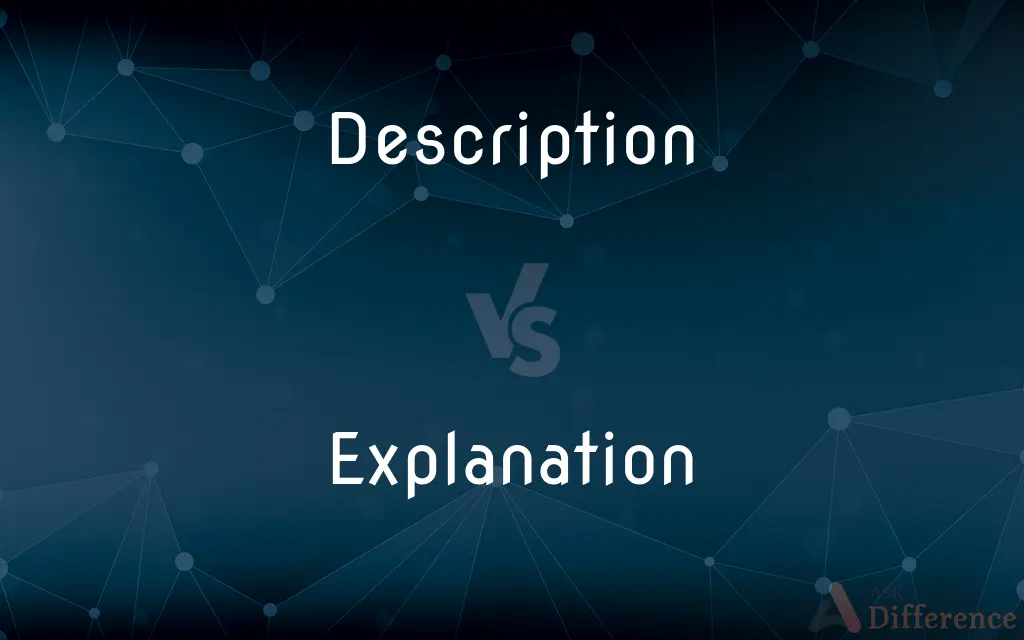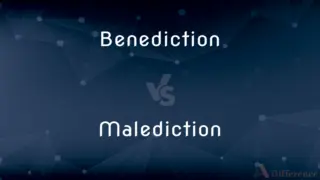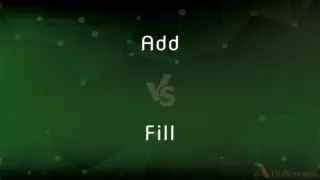Description vs. Explanation — What's the Difference?
By Maham Liaqat & Fiza Rafique — Updated on March 14, 2024
A description provides details about features and characteristics, while an explanation clarifies causes, reasons, or mechanisms.

Difference Between Description and Explanation
Table of Contents
ADVERTISEMENT
Key Differences
A description focuses on portraying or depicting something in detail, emphasizing the sensory and physical attributes or characteristics. For example, a description of a painting would highlight its colors, shapes, and the emotions it evokes. On the other hand, an explanation delves into the underlying reasons or causes behind a phenomenon, such as explaining why certain colors were dominant in a particular art movement, linking it to historical or social contexts.
While descriptions often appeal to the senses and aim to create a vivid mental image or understanding of the subject, explanations seek to provide insight or understanding into how or why something occurs. Descriptions might detail the intricate design of a machine, noting its components and layout, whereas explanations would cover how these components work together to achieve a particular function.
Descriptions are typically more neutral, aiming to convey what is observed without necessarily addressing the 'why' or 'how' behind it. For example, describing a landscape involves detailing the elements like mountains, rivers, and flora. In contrast, explanations inherently involve a degree of analysis or interpretation, such as explaining how geographical features are shaped by natural processes like erosion and tectonic activity.
The purpose of a description is often to inform, entertain, or evoke a sensory response, making it a common tool in creative writing, journalism, and reporting. Meanwhile, the goal of an explanation is to educate, clarify, or solve problems, making explanations crucial in scientific research, education, and technical fields.
Descriptions can stand alone as complete accounts of a subject based on observable attributes, whereas explanations frequently depend on existing knowledge or theories and aim to connect new observations to broader understandings or contexts. For instance, describing a species involves noting its appearance and behaviors, while explaining its traits might involve discussing evolutionary adaptations.
ADVERTISEMENT
Comparison Chart
Focus
Features and characteristics
Causes, reasons, mechanisms
Appeal
Sensory and physical attributes
Insight into how or why something occurs
Purpose
Inform, entertain, evoke sensory response
Educate, clarify, solve problems
Nature
Neutral, observational
Analytical, interpretative
Dependency
Stand-alone accounts based on observation
Relies on existing knowledge or theories
Compare with Definitions
Description
The act of depicting or portraying something in detail.
The novel's vivid description of the countryside brought the setting to life.
Explanation
The act of making something clear or understandable.
The teacher's explanation of photosynthesis clarified the concept for students.
Description
A representation of features, traits, or attributes.
The brochure provides a detailed description of each tour package.
Explanation
An interpretation that elucidates how or why something occurs.
The documentary offers an explanation of the economic crisis.
Description
The specification of an object, person, or event.
The witness gave a detailed description of the suspect to the police.
Explanation
The rationale behind an action, decision, or phenomenon.
She gave an explanation for her late arrival, citing traffic issues.
Description
A depiction that focuses on observable qualities.
The guidebook includes a description of the local wildlife.
Explanation
A statement or account that clarifies causes or reasons.
The scientist provided an explanation for the unexpected results.
Description
An account that emphasizes sensory perceptions.
His description of the meal made everyone's mouth water.
Explanation
A clarification that connects observations to underlying principles.
The book includes an explanation of the principles behind renewable energy.
Description
Description is the pattern of narrative development that aims to make vivid a place, object, character, or group. Description is one of four rhetorical modes (also known as modes of discourse), along with exposition, argumentation, and narration.
Explanation
An explanation is a set of statements usually constructed to describe a set of facts which clarifies the causes, context, and consequences of those facts. This description may establish rules or laws, and may clarify the existing rules or laws in relation to any objects, or phenomena examined.Explanation, in philosophy, is a set of statements that makes intelligible the existence or occurrence of an object, event, or state of affairs.
Description
A spoken or written account of a person, object, or event
People who had seen him were able to give a description
Explanation
The act or process of explaining
Launched into a detailed explanation.
Description
A type or class of people or things
It is laughably easy to buy drugs of all descriptions
Explanation
Something that explains
That was supposedly the explanation for their misdeeds.
Description
The act, process, or technique of describing.
Explanation
A mutual clarification of misunderstandings; a reconciliation.
Description
A statement or an account describing something
Published a description of the journey.
Gave a vivid description of the game.
Explanation
The act or process of explaining.
The explanation was long and drawn-out.
Description
A pictorial representation
Monet's ethereal descriptions of haystacks and water lilies.
Explanation
Something that explains, makes understandable.
An explanation for the UFO sightings was easily found.
Description
A kind or sort
Cars of every size and description.
Explanation
A resolution of disputed points pursuant to discussion; a mutual clarification of disputed points; reconciliation.
Description
A sketch or account of anything in words; a portraiture or representation in language; an enumeration of the essential qualities of a thing or species.
Give a verbal description of the events
A realistic description
Explanation
The act of explaining, expounding, or interpreting; the act of clearing from obscurity and making intelligible; as, the explanation of a passage in Scripture, or of a contract or treaty.
Description
The act of describing; a delineation by marks or signs.
Explanation
That which explains or makes clear; as, a satisfactory explanation.
Description
A set of characteristics by which someone or something can be recognized.
The zoo had no lions, tigers, or cats of any description.
Explanation
The meaning attributed to anything by one who explains it; definition; interpretation; sense.
Different explanations [of the Trinity].
Description
(taxonomy) A scientific documentation of a taxon for the purpose of introducing it to science.
The type description of the fungus was written by a botanist.
Explanation
A mutual exposition of terms, meaning, or motives, with a view to adjust a misunderstanding, and reconcile differences; reconciliation; agreement; as, to come to an explanation.
Description
(linguistics) The act or practice of recording and describing actual language usage in a given speech community, as opposed to prescription, i.e. laying down norms of language usage.
Explanation
A statement that makes something comprehensible by describing the relevant structure or operation or circumstances etc.;
The explanation was very simple
I expected a brief account
Description
(linguistics) A descriptive linguistic survey.
Explanation
Thought that makes something comprehensible
Description
The act of describing; a delineation by marks or signs.
Explanation
The act of explaining; making something plain or intelligible;
I heard his explanation of the accident
Description
A sketch or account of anything in words; a portraiture or representation in language; an enumeration of the essential qualities of a thing or species.
Milton has descriptions of morning.
Description
A class to which a certain representation is applicable; kind; sort.
A difference . . . between them and another description of public creditors.
The plates were all of the meanest description.
Description
A statement that represents something in words
Description
The act of describing something
Description
Sort or variety;
Every description of book was there
Common Curiosities
Can a description be subjective?
Descriptions can have subjective elements, especially in creative writing, where personal perceptions and emotions may influence the portrayal.
What distinguishes a description from an explanation?
A description details what something is like, while an explanation provides reasons or causes behind something.
Can a text include both descriptions and explanations?
Yes, many texts, especially in educational or scientific contexts, combine descriptions of phenomena with explanations of their underlying causes or mechanisms.
Is a description always visual?
While descriptions often emphasize visual characteristics, they can also involve other senses, such as sound, smell, taste, and touch.
Can a product description be considered an explanation?
A product description typically focuses on features and benefits, which is more descriptive, but it can include explanatory elements, such as how a feature works.
How do cultural perspectives influence descriptions?
Cultural backgrounds can shape the way things are described, influencing what details are highlighted and how they are interpreted.
Are explanations always factual?
Explanations aim to be based on facts, theories, or evidence, but they can sometimes be speculative, especially in areas with incomplete knowledge.
What makes a good explanation?
A good explanation is clear, logical, based on evidence or well-established theories, and connects new information to existing knowledge.
What role do explanations play in science?
Explanations are fundamental in science, as they help to theorize and make sense of observations, leading to new discoveries and advancements.
Why is an explanation important?
Explanations are crucial for understanding the workings and reasons behind phenomena, helping us make sense of the world and solve problems.
How does a description benefit the reader or listener?
Descriptions enhance understanding and appreciation by creating vivid mental images or conveying the essence of a subject.
Can a description change over time?
Yes, descriptions can change as perspectives shift or additional information becomes available, especially in dynamic or evolving subjects.
What is the value of explanations in education?
Explanations are vital in education for building understanding, fostering critical thinking, and connecting concepts across different subjects.
How do descriptions enhance storytelling?
In storytelling, descriptions set the scene, evoke atmosphere, and give depth to characters and settings, enriching the narrative.
What challenges might arise in forming explanations?
Challenges include ensuring accuracy, avoiding oversimplification, and addressing complex or multifaceted causes in a comprehensible way.
Share Your Discovery

Previous Comparison
Benediction vs. Malediction
Next Comparison
Add vs. FillAuthor Spotlight
Written by
Maham LiaqatCo-written by
Fiza RafiqueFiza Rafique is a skilled content writer at AskDifference.com, where she meticulously refines and enhances written pieces. Drawing from her vast editorial expertise, Fiza ensures clarity, accuracy, and precision in every article. Passionate about language, she continually seeks to elevate the quality of content for readers worldwide.














































